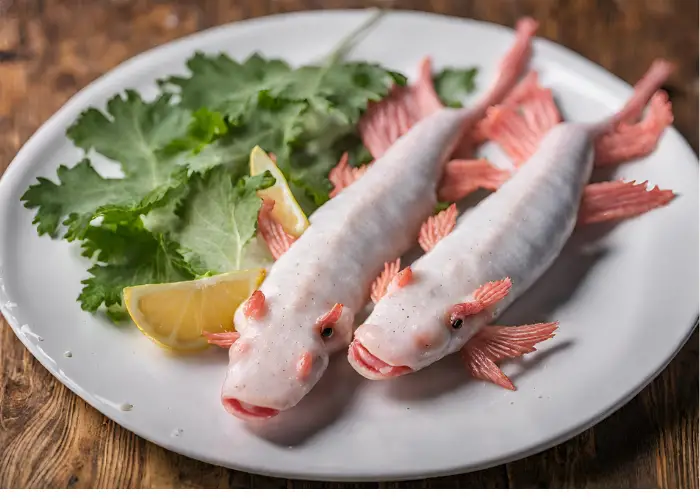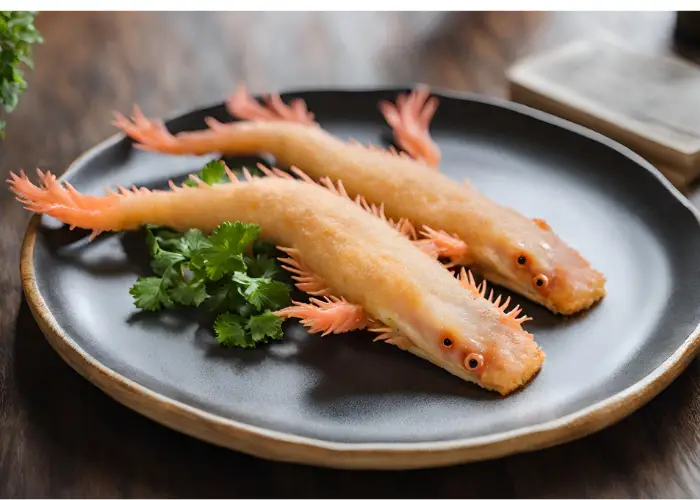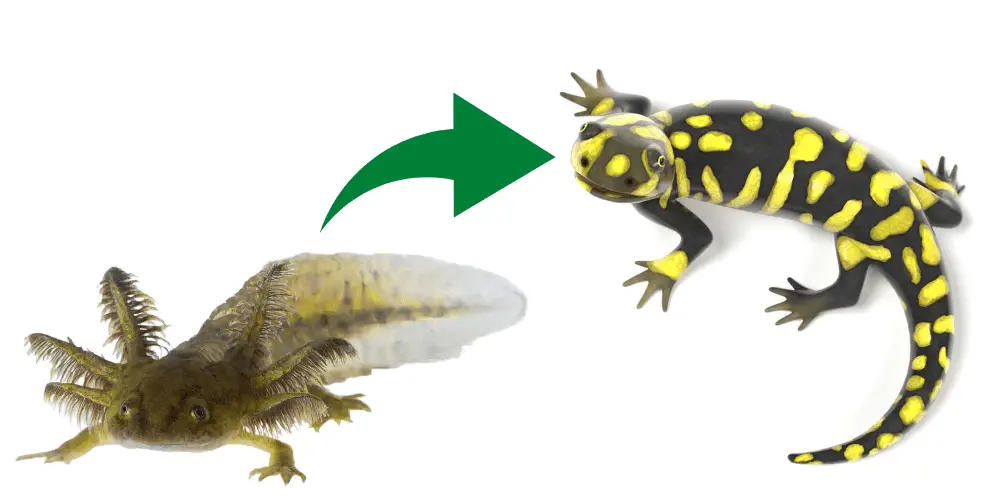In a world brimming with exotic delicacies, one might wonder about the Axolotl(Ambystoma mexicanum), a creature more commonly known for its regenerative abilities than being a meal. A question lingers: Do people eat axolotls?
People eat axolotls, which are rare due to their critically endangered status. Historically, axolotls were a staple in the Aztec diet. Today, their consumption is generally frowned upon and often illegal, but may still occur in certain localities.
This article explores the historical, cultural, and ethical dimensions of consuming axolotls, which raises important questions in today’s conservation landscape.
Historical Context

The Axolotl in Aztec Culture
The axolotl, often mistaken for a fish due to its aquatic nature, is an amphibian, a salamander that has captured the hearts of many due to its perpetual larval state and regenerative abilities.
This fascinating creature, native to the lake complex of Xochimilco near Mexico City, holds a significant place in Aztec mythology.
It is associated with the god Xolotl, the twin of Quetzalcoatl, who was believed to have transformed into an axolotl to escape being sacrificed.
Beyond mythology, axolotls were a staple in the Aztec diet, a fact documented in historical texts such as the Florentine Codex, which provides a glimpse into the culinary habits of the Aztecs.
From Delicacy to Endangered Species
The axolotl’s journey from a Mesoamerican delicacy to a critically endangered species is a stark example of the impact of urbanization and environmental degradation.
The International Union for Conservation of Nature (IUCN) now lists the axolotl as critically endangered, with its population in the wild facing severe threats from habitat destruction and water pollution.
Conservation efforts are crucial to prevent the species from becoming extinct, as the axolotl’s natural habitat in Xochimilco has become one of the world’s most at-risk ecosystems.
Current Practices

Modern Consumption: Myth or Reality?
While the Aztecs’ historical consumption of axolotls is well-documented, whether this practice continues today is more complex.
Axolotls are now considered critically endangered, largely due to the rapid urbanization of their natural habitat and ensuing environmental challenges.
As a result, eating axolotls is generally frowned upon and, in many areas, actively discouraged or even illegal.
However, anecdotal reports suggest that axolotl consumption may still occur in certain localities, particularly where traditional practices persist.
The Role of Captive Breeding
The ethical implications of consuming captive-bred axolotls instead of wild specimens spark a complex debate.
Captive breeding has become a significant industry for the pet trade and scientific research.
Some argue that consuming animals bred in captivity does not impact wild populations. However, others raise concerns about the ethics of breeding and consuming a species endangered in its natural habitat.
Organizations like CITES regulate the international trade of endangered species, including axolotls, to ensure that such activities do not threaten their survival in the wild.
Ethical Considerations

The Dilemma of Eating Endangered Species
The morality of consuming an endangered species like the axolotl poses significant ethical questions.
The axolotl’s status as a critically endangered species brings issues of biodiversity loss and species conservation to the forefront.
The debate is about survival and the ethical implications of consuming a teetering creature on the edge of extinction.
Conservationists argue that every effort should be made to protect such species, which includes discouraging practices that could normalize or trivialize their consumption.
Pet vs. Food: A Cultural Conundrum
Axolotls have gained popularity as exotic pets around the world, further complicating the ethics of their consumption.
Eating an animal commonly kept as a pet challenges societal norms and raises questions about the arbitrary distinctions we make between pets and food.
This dichotomy is explored in discussions on animal welfare platforms and ethical debates, such as The Conversation, where the nuances of such ethical dilemmas are unpacked.
Legal and Conservation Efforts
Laws and Protections
The legal framework surrounding the protection of axolotls varies by country, but trade and consumption are generally restricted to protect the species from further decline.
International agreements like CITES play a crucial role in regulating the trade of endangered species, including axolotls, to ensure their survival.
Conservation Initiatives
Efforts to conserve the axolotl involve habitat restoration, pollution control, and scientific research.
Organizations such as Amphibian Ark are dedicated to conserving amphibian species worldwide, including axolotls.
It promotes sustainable practices and educates the public about the importance of amphibians in our ecosystems.
Cultural Perspectives

A Global View on an Ancient Practice
While largely obsolete, the practice of eating axolotls still resonates within certain cultural narratives.
It’s essential to approach this topic with cultural sensitivity, acknowledging that dietary choices are often deeply rooted in tradition and history.
In Mexico, the axolotl is not only a biological entity but also a cultural symbol, featured in art and folklore, and its historical consumption is a testament to the country’s rich gastronomic heritage.
Respecting Traditions in the Face of Conservation
As global awareness of conservation grows, so does the dialogue around sustainable practices.
It’s a delicate balance between respecting cultural dietary practices and advocating for preserving a species like the axolotl.
This balance is explored in conservation discussions, such as those facilitated by organizations like UNESCO, emphasizing the importance of integrating cultural heritage and biodiversity conservation.
The Role of Education and Awareness
Educating the public about the axolotl’s plight is crucial in shifting perceptions and practices.
Conservation campaigns often raise awareness about the species’ role in the ecosystem and its cultural significance.
By promoting understanding, organizations hope to foster a sense of stewardship that transcends cultural boundaries.
Resources like EDGE of Existence highlight the axolotl as one of the most evolutionarily distinct and globally endangered (EDGE) species, emphasizing the need for immediate conservation action.
Conclusion

The exploration into whether people consume axolotls today has unraveled a complex tapestry of history, culture, and ethics.
From their revered status in ancient Aztec civilization to their current plight as a critically endangered species, axolotls symbolize the delicate interplay between human activity and biodiversity.
The conversation around their consumption concerns dietary choices and a broader discussion on conservation, ethical responsibility, and cultural sensitivity.
Call to Action
We must take collective action in the face of the axolotl’s uncertain future. Here are ways you can contribute:
- Support Conservation: Support organizations like WWF actively working to conserve axolotl populations and their habitats.
- Educate and Raise Awareness: Share information about the axolotl’s unique biology and conservation status. Resources like the IUCN Red List provide valuable information that can help spread awareness.
- Responsible Pet Ownership: If you choose to keep an axolotl as a pet, ensure that you are sourcing it responsibly and are committed to providing a lifetime of proper care. The Caudata Culture guide to axolotl care is an excellent resource for prospective and current axolotl owners.
This article serves as a starting point for deeper exploration and action. By understanding the axolotl’s role in our world, we can better appreciate the need for its conservation and the preservation of our planet’s rich biodiversity.
EXPLORE MORE AXOLOTL TOPICS BELOW:



